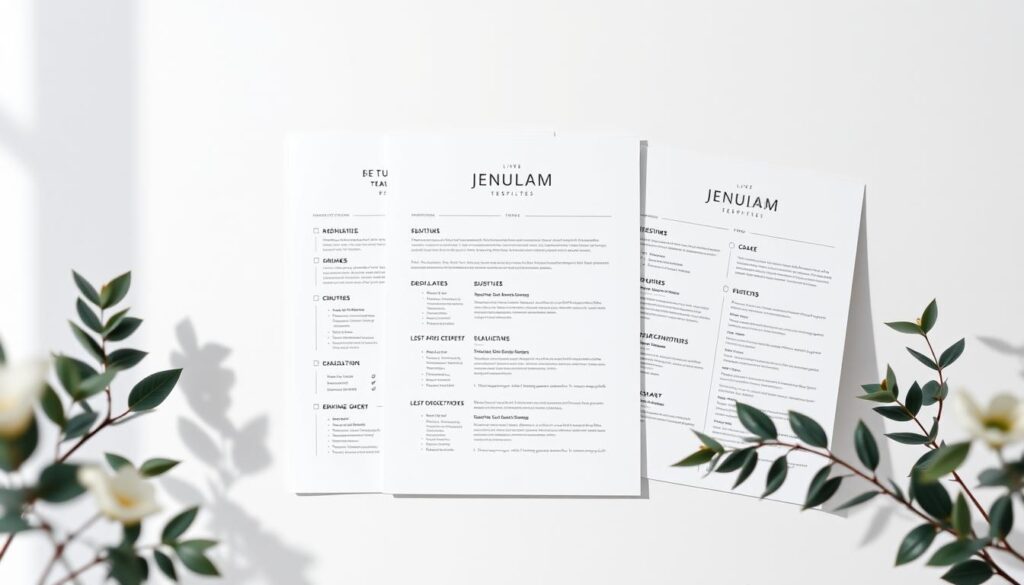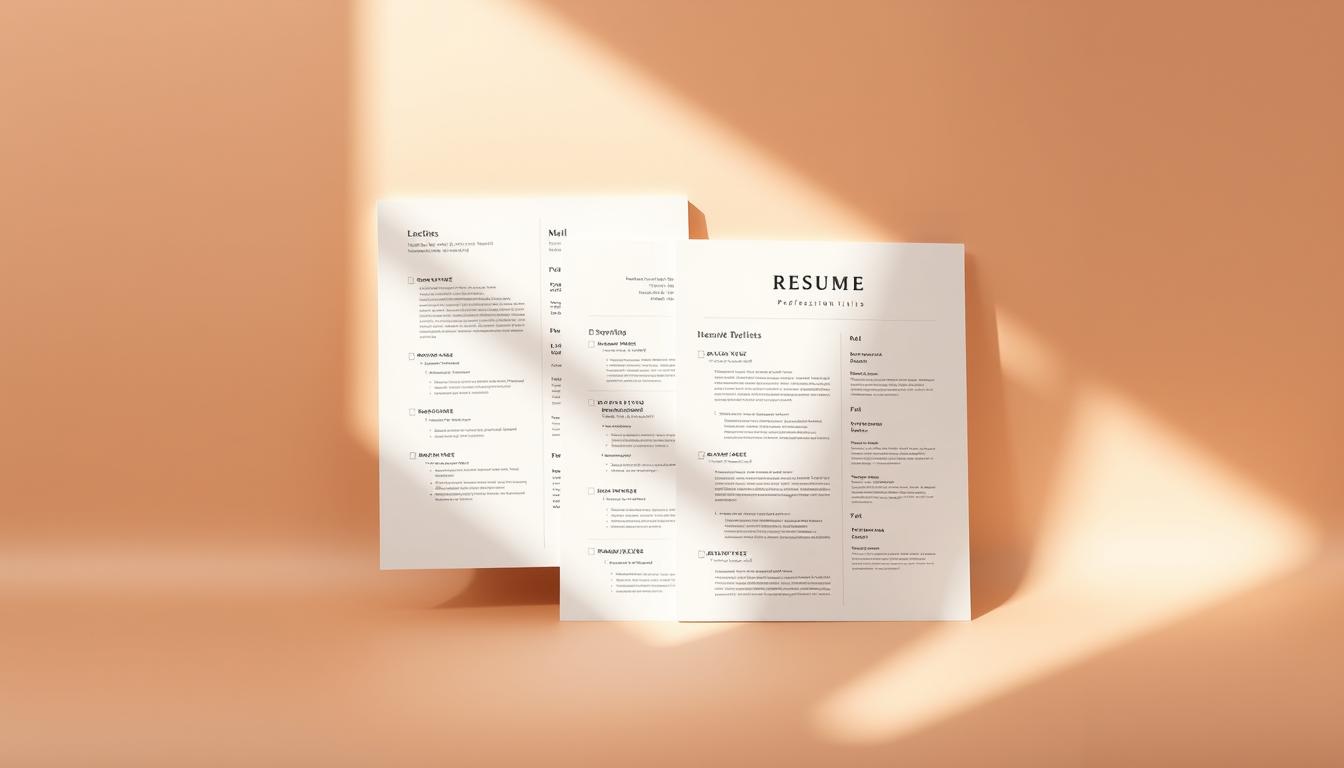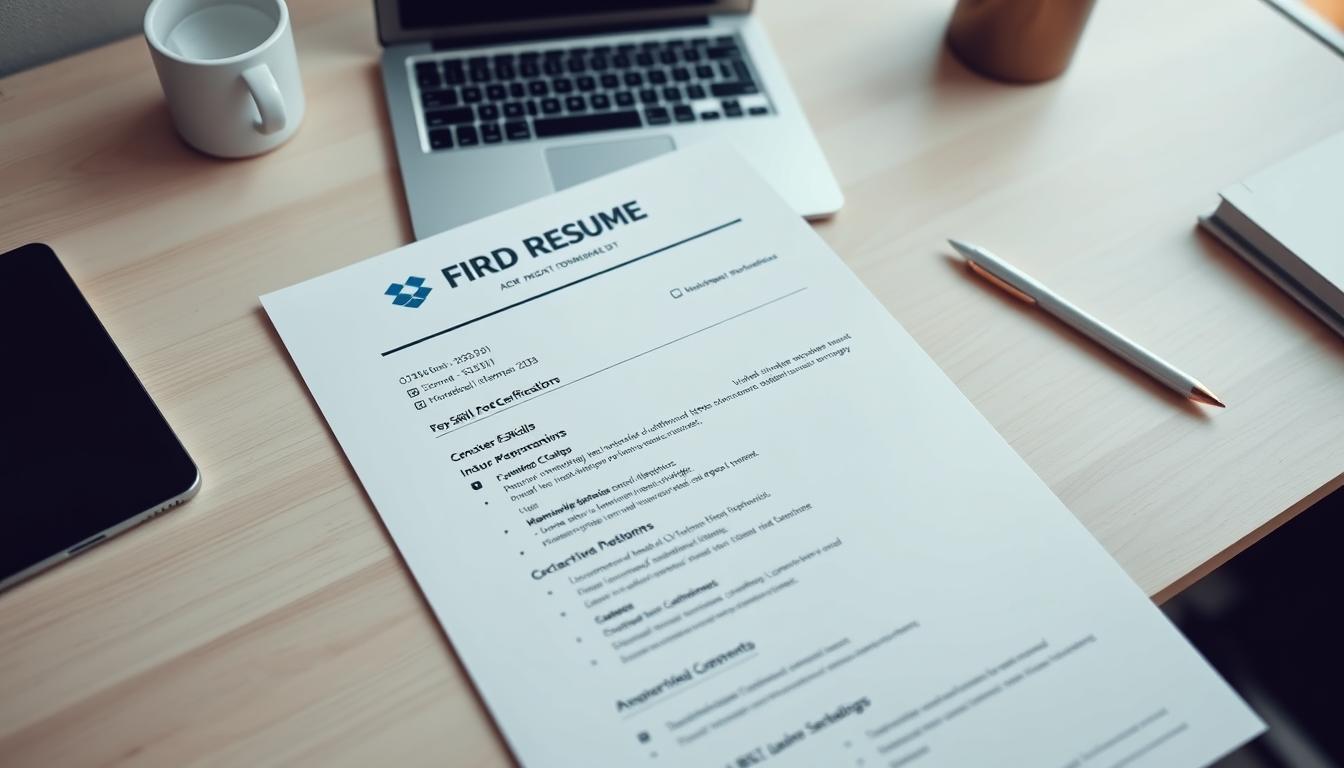Did you know that 75% of resumes never reach human eyes because of applicant tracking systems? The World Economic Forum says big changes will happen in jobs by 2025. It’s key to stand out in this new hiring world.
Your resume is your first chance to get a job. But, it’s not just about looking good. You need professional resume templates that work in today’s job market.
RoboApply makes applying for jobs easier with career advancement tools. Our platform uses AI to build resumes, check grammar, and get past ATS filters. It also has features like auto-apply Chrome extensions and interview coaching. These tools help you find jobs faster.
Recruiters only look at each resume for six seconds. Making your resume stand out can really help you get noticed among many applicants.
Key Takeaways
- 75% of resumes get filtered out by applicant tracking systems before reaching recruiters
- Professional resume templates increase your chances of passing ATS screening processes
- RoboApply offers comprehensive tools including AI builders, grammar checkers, and interview coaching
- The job market will undergo significant changes by 2025, requiring strategic resume approaches
- Recruiters spend only six seconds initially reviewing each resume submission
- Tailored resumes perform significantly better than generic applications
Understanding Job Search Strategies for Job Seekers
Job seekers today need strategies that keep up with the fast-changing job market. Artificial intelligence and automation are changing many industries. You need a plan that sets you apart from others.
The World Economic Forum says big changes are happening now. Analytical thinking, active learning, complex problem solving, and creativity are key skills for 2025. They also predict that humans and machines will work equally by 2025.
Your job search strategies must change too. Old methods won’t work in a market that values skills that work with technology, not against it.
“The future of work is not about humans versus machines, but about humans working with machines to create value that neither could achieve alone.”
| Traditional Job Search | Strategic Job Search | 2025 Market Advantage |
|---|---|---|
| Mass application submissions | Targeted industry research | Higher response rates |
| Generic resume for all jobs | Customized applications per role | Better ATS compatibility |
| Waiting for responses | Proactive follow-up system | Demonstrates initiative |
| Limited skill awareness | Comprehensive skill mapping | Matches emerging job requirements |
The Importance of a Focused Job Search
A focused job search boosts your chances of success. Targeting specific industries and roles lets you become an expert and speak their language.
Identify three to five industries that fit your background and interests. Look into their growth, hiring patterns, and needed skills. This focus helps you know what employers value.
Think about how automation affects your chosen fields. Fast-changing industries need people who can work with machines. Your search should focus on roles where human skills are still needed.
RoboApply’s job tracker helps you stay focused. It organizes your applications by industry and role. You can see which sectors respond best to your profile and adjust your strategy.
Recognizing Your Skills and Talents
Knowing your full skill set is more than listing past job duties. You need to find transferable skills that complement automation. This self-awareness gives you an edge.
Start with a skills audit. List your technical, soft, and unique skills. Focus on skills like human judgment, creativity, and problem-solving, where humans excel.
The World Economic Forum’s top skills for 2025 are a good guide:
- Analytical thinking and innovation – Your ability to analyze complex situations and develop creative solutions
- Active learning and learning strategies – How quickly you adapt to new information and technologies
- Complex problem-solving – Your capacity to navigate multifaceted challenges
- Critical thinking and analysis – Your skill in evaluating information and making informed decisions
Document examples of your skills in action. Use numbers to show your achievements. This preparation is key for interviews and applications.
Understanding your skills also means knowing what you need to improve. Honest self-assessment helps you find skill gaps that might limit your opportunities.
Setting Realistic Job Search Goals
Effective job search goals should be specific, measurable, and realistic. Realistic goal-setting keeps you motivated and focused.
Start by learning about hiring timelines in your target industries. Some sectors move fast, while others take longer. Knowing this helps you set realistic expectations.
Break your big goal into smaller, achievable steps:
- Weekly application targets – Aim for quality over quantity, typically 5-10 well-researched applications per week
- Networking milestones – Set goals for new professional connections and industry event attendance
- Skill development benchmarks – Identify specific certifications or training programs to complete during your search
- Follow-up schedules – Establish systematic approaches for job interview follow-up tips and maintaining candidate relationships
Consider market conditions when setting timeline goals. Economic factors, seasonal hiring, and industry trends affect job search speed. Strategic job searches usually take 3-6 months, depending on the role and market.
Your goals should include ways to measure progress. Track application rates, interview success, and networking effectiveness. This data helps you improve your strategy.
RoboApply’s outreach CRM supports goal tracking. It provides analytics on your application performance. You can see which strategies work best and adjust your approach based on data.
Remember to plan for follow-up activities. Knowing when and how to send a follow-up email after an interview shows professionalism. Include these touchpoints in your timeline and tracking system.
Crafting an Eye-Catching Resume
A well-crafted resume opens doors to opportunities by effectively showcasing your professional value proposition. Your resume must navigate both automated screening systems and human reviewers to land you that crucial interview. Understanding how to create a document that excels in both areas will significantly boost your job search success.
Modern hiring processes rely heavily on Applicant Tracking Systems (ATS) to filter candidates. Over 75% of companies use ATS software to screen resumes before human eyes ever see them. This reality means your resume needs strategic formatting and keyword optimization to pass digital gatekeepers.

The key to resume success lies in balancing visual appeal with technical functionality. You need a document that looks professional while containing the right elements for automated parsing. This balance requires careful attention to template selection, content customization, and strategic skill presentation.
Using Professional Resume Templates
Professional resume templates provide the foundation for creating ATS-friendly documents that catch hiring managers’ attention. RoboApply’s AI resume builder leads the market in creating optimized templates that combine modern design with technical compatibility. These templates ensure your resume passes through screening systems while maintaining visual appeal.
When selecting a template, prioritize clean layouts with clear section headers. Avoid templates with complex graphics, tables, or unusual fonts that confuse ATS systems. Simple, professional designs consistently outperform flashy alternatives in both automated screening and human review processes.
Consider these essential template features:
- Standard section headings like “Experience” and “Education”
- Consistent formatting throughout the document
- Readable fonts such as Arial, Calibri, or Times New Roman
- Adequate white space for easy scanning
- Contact information prominently displayed at the top
Professional templates also incorporate current design trends while maintaining functionality. They balance creativity with professionalism, ensuring your resume stands out for the right reasons. Quality templates save you hours of formatting time while delivering proven results.
Tailoring Your Resume for Each Job Application
Generic resumes rarely succeed in today’s competitive job market. Each application requires customization to match specific job requirements and company culture. This tailoring process involves adjusting keywords, emphasizing relevant experience, and aligning your presentation with the employer’s needs.
Start by analyzing the job description for key terms and requirements. Mirror the language used in the posting throughout your resume to improve ATS compatibility. If the job requires “project management,” use that exact phrase rather than “project coordination” or similar alternatives.
Customize your professional summary for each application. This section should immediately connect your background to the specific role. For example:
“Results-driven marketing professional with 5+ years of digital campaign experience and proven track record of increasing conversion rates by 40% through data-driven strategies.”
Reorder your experience bullets to prioritize the most relevant accomplishments. Place achievements that directly relate to the target position at the top of each role description. This strategic positioning helps both ATS systems and human reviewers quickly identify your qualifications.
Remember that effective resume customization extends beyond the application process. A well-tailored resume sets the stage for successful interviews and even influences your job interview thank you note content. When you clearly understand how your background aligns with the role, you can craft more compelling follow-up communications, including any follow-up call after interview conversations.
Highlighting Key Skills and Experience
Strategic skill presentation transforms your resume from a simple work history into a compelling professional narrative. Focus on skills that align with the World Economic Forum’s identified future-ready competencies: critical thinking, creativity, and technology proficiency. These competencies resonate with forward-thinking employers across industries.
Quantify your achievements whenever possible. Numbers provide concrete evidence of your impact and help your accomplishments stand out. Instead of writing “Improved sales performance,” specify “Increased quarterly sales by 25%, generating $2.3M in additional revenue.”
Create a dedicated skills section that balances hard and soft skills. Include technical competencies relevant to your field alongside interpersonal abilities that demonstrate leadership potential. Use a mix of industry-specific terms and transferable skills to appeal to various screening criteria.
| Skill Category | Examples | Presentation Method | ATS Optimization |
|---|---|---|---|
| Technical Skills | Python, SQL, Adobe Creative Suite | Bullet points with proficiency levels | Use exact software names |
| Leadership Skills | Team management, strategic planning | Integrated into experience descriptions | Include action verbs |
| Industry Knowledge | Regulatory compliance, market analysis | Contextual examples with results | Match job posting terminology |
| Communication | Public speaking, technical writing | Specific examples and outcomes | Use standard industry terms |
Position your most impressive achievements prominently within the first third of your resume. Hiring managers typically spend only 6-8 seconds on initial resume reviews, making early impact crucial. Front-load your strongest qualifications to capture attention immediately.
Consider including a “Key Achievements” section that highlights your top 3-4 accomplishments across different roles. This approach allows you to showcase diverse successes while maintaining focus on results that matter most to potential employers.
Remember that skill highlighting extends beyond your resume into interview preparation and follow-up communications. The skills you emphasize should align with stories you’re prepared to tell during interviews and topics you might discuss in post-interview conversations.
Writing a Compelling Cover Letter
In today’s job market, a good cover letter can make a big difference. It can move your application from the rejection pile to the interview list. Your cover letter is a chance to show your personality, communication skills, and interest in the job and company.
Companies use both machines and people to check applications. Your cover letter can make you stand out from others with similar skills. It’s your chance to tell your professional story in a way that matches the employer’s needs and values.
The Purpose of a Cover Letter
Your cover letter does more than just introduce yourself. It shows your writing skills, which are key in most jobs. Hiring managers look at your ability to write clearly and professionally.
The letter also lets you talk about any concerns or gaps in your resume. If you’re changing careers or have gaps, your cover letter can explain these in a positive way. You can show how your skills and experience are valuable for the job.
Most importantly, your cover letter shows you’ve done your homework on the company and job. It shows you understand the company’s mission, values, and challenges. This shows you’re genuinely interested and can be a good fit for their team.
“The best cover letters don’t just repeat what’s on the resume—they tell a story about why this particular job at this particular company is the perfect next step in your career journey.”
Key Elements to Include
Every good cover letter has key elements that tell a story. Your opening paragraph should grab attention by mentioning the job and why you’re a great fit. Don’t start with a generic “I am writing to apply for the position.”
The body paragraphs should highlight your most relevant achievements. Use specific examples with numbers whenever you can. Instead of saying “I increased sales,” say “I increased sales by 25% over six months by implementing a new customer retention strategy.”
Your closing paragraph should include a clear call to action. Show your enthusiasm for the opportunity and mention you’ll follow up soon. This shows you’re proactive and professional.
| Cover Letter Section | Key Purpose | Essential Elements | Common Mistakes |
|---|---|---|---|
| Opening Paragraph | Capture attention immediately | Specific position title, compelling hook, brief value proposition | Generic greetings, vague statements, focusing on what you want |
| Body Paragraphs | Demonstrate qualifications | Specific achievements, quantified results, relevant skills | Repeating resume content, lack of examples, generic statements |
| Closing Paragraph | Encourage next steps | Clear call to action, follow-up timeline, professional enthusiasm | Weak endings, no follow-up mention, overly aggressive tone |
| Overall Format | Professional presentation | Proper business format, error-free writing, appropriate length | Poor formatting, spelling errors, excessive length |
Personalizing Your Approach
Personalizing your cover letter makes it stand out. Research the company well before you start. Learn about their culture, challenges, and recent news. This helps you tailor your message to fit their needs.
Try to address your letter to a specific person. If you can’t find a name, check the company’s website or LinkedIn. Using a specific name shows you’ve done your homework.
Make sure your examples and achievements match the job’s requirements. If teamwork is key, highlight your team projects. If leadership is important, talk about your management experiences. This shows you understand what the employer values.
Think about the company’s style and culture when writing. A startup might like a casual, creative approach, while a traditional company wants formal language. Matching their tone shows you fit in, which is crucial to employers.
Remember, your cover letter is the first impression you make. It sets the stage for all future communications with employers. By taking the time to write a personalized, compelling cover letter, you’re showing you’re serious about the job. This is a key part of the job interview follow-up process.
Utilizing Online Job Boards Effectively
Getting the most out of online job boards is more than just posting your resume. You need a smart plan to stand out and make applying easier. Choosing the right platforms, optimizing your profile, and using automation can make your job search more efficient.
The job market today is full of digital opportunities. But, to succeed, you must know how each platform works and tailor your strategy. With LinkedIn having over one billion users worldwide and indeed serving 350+ million employers, the competition is tough.
Popular Job Boards to Consider
Start by choosing platforms that offer great features and reach. RoboApply is a standout solution that works with many job boards and automates your applications. This Chrome extension saves you hours while keeping your applications top-notch.
LinkedIn is the top professional networking site for career growth. It connects you with hiring managers and recruiters. The platform favors active users who engage and keep their profiles up to date.
Despite its massive employer database, indeed is highly competitive. To stand out, optimize your keywords and make your profile compelling.
Here are more platforms to consider based on your industry:
- Glassdoor – Offers job listings, company reviews, and salary insights
- ZipRecruiter – Uses AI to match candidates with jobs
- Monster – Provides career advice and job listings
- CareerBuilder – Focuses on industry-specific jobs and resources
Industry-specific boards can be more effective for specialized roles. Research shows that 66% of companies use free job boards and 75% use paid ones for hiring. Using multiple platforms increases your chances of being found.
Tips for Optimizing Your Job Board Profile
Your profile is your digital first impression. Start with a professional photo that shows confidence and approachability. Avoid casual or outdated photos.
Create a compelling headline that highlights your skills and value. Instead of just listing your job title, include your expertise and achievements. For example, “Digital Marketing Manager | Lead Generation Expert | ROI-Focused Campaign Strategist.”
Your summary should tell your professional story in 3-4 paragraphs. Focus on your achievements rather than just listing your job responsibilities. Use specific numbers and metrics to show your impact.
Keyword optimization is key for searchability. Research job descriptions and use relevant terms naturally in your profile. But avoid keyword stuffing, which can make your content sound robotic.
Here are some optimization strategies:
- Skills section completion – List both hard and soft skills relevant to your industry
- Experience details – Include quantifiable achievements for each role
- Education and certifications – Keep this section current with recent training
- Regular updates – Fresh content signals active job searching to algorithms
Consistency across platforms builds credibility. Your LinkedIn profile should match your resume and other job board profiles. Discrepancies can raise red flags with potential employers.
Setting Up Job Alerts
Smart job alerts help you stay on top of opportunities without feeling overwhelmed. Most platforms let you set multiple alerts with different criteria. Create specific alerts for your ideal roles and broader ones for exploring new possibilities.
Configure alerts based on these parameters:
- Job title variations – Include synonyms and related positions
- Location preferences – Set radius parameters for commutable distances
- Company size – Filter by startup, mid-size, or enterprise organizations
- Experience level – Match alerts to your career stage
- Salary range – Set realistic expectations based on market research
Timing is important when setting up alerts. Set them to arrive during your most productive job search hours. Many successful candidates check alerts first thing in the morning to apply quickly.
RoboApply’s intelligent alert system goes beyond basic notifications. It analyzes job descriptions and automatically applies to positions matching your criteria. This automation ensures you’re among the first applicants, significantly improving your response rates.
Consider the job interview follow-up timeline when managing multiple applications through alerts. Keep detailed records of where you’ve applied and when to follow up. Understanding how to follow-up after interviewing becomes crucial as your alert-driven applications generate more interview opportunities.
Review and adjust your alert criteria regularly. What works at the start of your search may need refinement as you learn more about available opportunities and market conditions. Successful job seekers treat alerts as dynamic tools that evolve with their search strategy.
Networking: Your Secret Weapon
Networking can open doors to jobs that aren’t advertised. 80% of jobs are never publicly advertised, making connections key. By using professional networking strategies, you turn job hunting into building relationships.
LinkedIn shows companies often hire through referrals and networking. This means your next job might come from who you know, not just job boards. The best job seekers focus on building real relationships, not just collecting cards.

Leveraging Social Media Platforms
LinkedIn is the top site for professional networking, with over 900 million users. Your LinkedIn profile is like a digital business card. Make a good first impression by using a professional photo, a catchy headline, and a detailed summary.
Here are some career networking tips for LinkedIn:
- Share valuable content regularly – Post industry insights, comment thoughtfully on others’ posts, and share relevant articles
- Join industry-specific groups – Participate in discussions and connect with group members who share your professional interests
- Use LinkedIn’s search filters – Find professionals by company, role, location, and mutual connections
- Send personalized connection requests – Reference shared connections, mutual interests, or specific reasons for connecting
- Engage with your network consistently – Like, comment, and share content from your connections to stay visible
For industry talks, use Twitter. For creative fields, Instagram is great. Each platform offers unique networking chances.
Joining Professional Associations
Professional associations offer a place to meet peers and leaders. They give exclusive access to job boards, mentorship, and events not open to the public.
Look for associations in your field and career goals. Most industries have national groups with local chapters. This gives you broad connections and local networking chances.
Here’s how to make the most of association membership:
- Attend events regularly – Show up often to build recognition and deepen relationships
- Volunteer for committees – Show leadership and work closely with others
- Participate in online forums – Engage in digital discussions between events
- Mentor newer members – Build your reputation and expand your network
- Present at conferences – Show yourself as a leader in your field
Being in an association can lead to many career opportunities. Many members find their best jobs through these connections.
Reaching Out to Industry Influencers
Reaching out to influencers can give you valuable insights and introductions. But, you need to approach them with strategic thinking and a clear value proposition. Show respect for their time and offer something meaningful in return.
Here are some professional networking strategies for reaching out to influencers:
- Research thoroughly before reaching out – Know their work, recent projects, and interests
- Engage with their content first – Comment on their posts and share their content
- Craft personalized messages – Mention specific work and explain why you’re reaching out
- Offer value upfront – Share insights, introduce useful connections, or offer help
- Keep initial requests small – Ask for advice, not job referrals, first
Tools like RoboApply’s outreach CRM help manage these relationships. Track interactions, set reminders, and keep notes on each connection’s interests.
Building relationships with influencers takes time and patience. Focus on providing value and building real connections. The best networking relationships grow over months or years of consistent interaction.
Your networking efforts will grow over time, creating a network that supports your career. Start building these connections today, and you’ll have a strong support system when you need it.
Preparing for Job Interviews
Getting ready for an interview is key to success. Effective interview preparation strategies turn nervous candidates into confident professionals. They can clearly show their value to employers.
The job market today wants candidates who are resilient and flexible. These qualities show in how you answer questions and present yourself. Thorough preparation helps you show these qualities confidently.
Common Interview Questions and How to Answer
Knowing how to answer common interview questions is crucial. Use the STAR method to craft answers that show your problem-solving skills.
Essential questions you should prepare for include:
- “Tell me about yourself” – Focus on your professional journey and achievements
- “Why do you want this position?” – Connect your goals with the company’s objectives
- “Describe a challenging situation you overcame” – Show your resilience and critical thinking
- “Where do you see yourself in five years?” – Show your career planning and ambition
- “What are your greatest strengths and weaknesses?” – Show self-awareness and a growth mindset
Here’s an example for handling the weakness question:
“I used to struggle with delegation because I wanted to ensure everything met my high standards. But this approach limited team growth and my own capacity. I’ve since developed a system where I clearly communicate expectations, provide necessary resources, and schedule regular check-ins. This change has improved team productivity by 30% while maintaining quality standards. I continue working on trusting my team members’ capabilities while being available for guidance when needed.”
Practice your answers with RoboApply’s interview coach. It gives you personalized feedback and helps you improve. This tool simulates real interview conditions and builds your confidence.
The Importance of Researching Companies
Researching companies is crucial for job interview success tips. It shows you’re genuinely interested and helps tailor your responses. Thorough research also lets you ask smart questions that impress interviewers.
Focus on these areas:
- Company mission and values – Understand their core principles and culture
- Recent news and developments – Stay current with company announcements and industry trends
- Leadership team – Learn about key executives and their backgrounds
- Competitors and market position – Understand their industry landscape
- Growth opportunities – Identify potential career advancement paths
Use this information to ask thoughtful questions. For example, ask how recent company initiatives align with industry trends or how the role contributes to organizational goals.
| Research Source | Information Type | Key Benefits | Time Investment |
|---|---|---|---|
| Company Website | Mission, values, recent news | Official messaging and culture insights | 30-45 minutes |
| LinkedIn Company Page | Employee profiles, company updates | Team structure and professional networks | 20-30 minutes |
| Industry Publications | Market trends, competitive analysis | Broader context and strategic insights | 15-20 minutes |
| Glassdoor Reviews | Employee experiences, salary data | Internal culture and compensation insights | 15-20 minutes |
Dress Code and Professional Presentation
Your professional presentation shows competence and respect. Interview preparation strategies include paying attention to dress code and body language. Different industries have different expectations, so research what’s appropriate for your field.
Follow these guidelines for professional presentation:
- Conservative business attire for traditional industries like finance or law
- Business casual for tech companies or creative agencies
- Clean, well-fitted clothing regardless of industry standards
- Minimal accessories that don’t distract from your message
- Good personal hygiene including fresh breath and clean nails
Your body language shows confidence and professionalism. Maintain eye contact, offer a firm handshake, and sit up straight. Practice these behaviors beforehand so they feel natural during the interview.
For virtual interviews, make sure your technology works and your background looks professional. Test your camera angle, lighting, and audio quality in advance. Position your camera at eye level to maintain natural eye contact with interviewers.
Remember, flexibility and stress tolerance show in how you handle unexpected situations during interviews. Whether dealing with technical difficulties or challenging questions, your composed response demonstrates the adaptability employers seek in 2025’s dynamic workplace.
Following Up Post-Interview
The moments after your interview are crucial. They give you a chance to show you’re the best fit for the job. Professional follow-up communication is key to keeping your interest high and showing you’re professional in a competitive job market. How you follow up can make all the difference between getting the job and missing out.
Good follow-up is more than just saying thank you. It shows you’re really interested in the job and know how to act professionally. The goal is to be enthusiastic but not too pushy.

Crafting a Thoughtful Thank-You Note
Your job interview thank you note is your first chance to impress after the interview. It should be more than just a thank you. Instead, it should highlight your skills and talk about specific things you discussed during the interview.
Start with details from your interview. Mention specific projects, challenges, or company plans that caught your attention. This shows you were really listening and interested.
Here’s a ready-to-use example for your thank-you email:
Subject: Thank you for our conversation about the Marketing Manager position
Dear [Interviewer’s Name],
Thank you for talking with me about the Marketing Manager job yesterday. I was excited to hear about your new product and how the job would involve creating campaigns.
Our talk made me even more eager to join [Company Name]. My experience with rebranding at [Previous Company] is a great match for your goals.
I’m looking forward to hearing from you next. If you need anything else, please let me know.
Best regards,
[Your Name]
Keep your message short but meaningful. Aim for 150-200 words that make a strong impact without being too long.
Timing Your Follow-Up
Timing is everything in follow-up. Send your thank-you email within 24 hours of the interview. This keeps you on the interviewer’s mind and shows you’re quick and professional.
Here’s a timeline for your follow-ups:
- Day 1: Send thank-you email to all interviewers
- Week 1: If no response, send a brief check-in email
- Week 2-3: Make a polite follow-up call if email is ignored
- Week 4: Send a final follow-up email
Hiring can take longer than expected. Companies might be interviewing many candidates or dealing with delays. Being patient and persistent shows you understand the business world.
When you send a follow-up email after the interview, stay professional and show you’re still interested. Try not to sound too eager or impatient, even if you’re feeling that way.
What to Do If You Don't Hear Back
Not hearing back can be frustrating, but it doesn’t always mean no. Many things can slow down hiring, like budget issues or company changes. Your response to silence shows a lot about your professionalism.
If you haven’t heard back, here are some job interview follow-up tips:
- Expand your contact network: Connect with other employees on LinkedIn
- Provide additional value: Share relevant articles or insights related to your interview
- Maintain visibility: Engage with the company’s social media content
- Set a deadline: Decide when to move on if you haven’t heard back
Sometimes, following up after an interview when there’s no response requires creative approaches. Try a LinkedIn message if email attempts fail, but don’t be too pushy.
Know when to move on. If you’ve tried three times in four weeks and still haven’t heard back, it’s time to look elsewhere. Send a final, polite email expressing your interest and asking to be considered for future jobs.
Here’s a template for your final follow-up:
Subject: Following up on Marketing Manager position
Hi [Interviewer’s Name],
I wanted to follow up again about the Marketing Manager job we talked about. I know hiring takes time, and I’m still very interested.
If things have changed or if you need more from me, please let me know. I’d also like to be considered for other roles that might come up.
Thank you again for your time and consideration.
Best regards,
[Your Name]
Professional follow-up is an investment in your career. Even if this job doesn’t work out, your thoughtful approach will be remembered for future opportunities.
Continuous Learning and Skill Development
To stay ahead in today’s job market, you must keep learning new skills. The job world changes fast, and employers want people who can adapt and grow. Learning new skills can open doors to new career opportunities.
The World Economic Forum says learning and adapting are key skills for 2025. Skills like technology design, programming, and data analysis are becoming more important. It’s crucial to keep up with these trends to stay valuable in the job market.
Identifying Industry Trends
Start by watching for trends in your industry. Read professional publications and industry reports. LinkedIn Learning and Harvard Business Review are great for insights into future skills.
Follow industry leaders on social media. Their posts often hint at upcoming changes. Join professional groups to get trend reports and network.
Set up Google Alerts for your industry keywords. This way, you get updates on market changes. Look at job postings to see which skills are in demand.

Online Courses and Certifications
Look for courses that match your career goals and industry trends. Coursera, edX, and Udemy have great programs from top sources. Focus on skills like data analysis and digital marketing.
Choose certifications that employers value. Google Analytics, AWS Cloud Practitioner, and PMP certification are highly regarded. Find out which certifications are best for your career path.
Make time for learning each day. Aim for 30-60 minutes. Use systems or spreadsheets to track your progress.
Use your new skills right away. This makes learning stick and shows you’re ready for new challenges. Remember, showing you’re always learning is key in job interviews.
Building a Professional Portfolio
Keep a record of your learning with a professional portfolio. Include courses, certifications, and projects. GitHub is good for tech projects, while Behance is better for creative work.
Write case studies to show off your problem-solving skills. Describe the challenge, your solution, and the results. This proves you’re ready for the job.
Keep your portfolio up to date with new achievements. Add testimonials from others when you can. This boosts your credibility.
Link your portfolio to your job search. Talk about your projects in interviews and share your portfolio links. When following up after an interview, mention any new portfolio updates.
Use RoboApply to track how your learning affects your job search. See which skills lead to more interviews and focus on those.
Staying Positive and Motivated During Your Search
Job searching can be tough, lasting five to six months and needing dozens of applications. Keeping your mental health and motivation is key for success in your career.
Overcoming Job Search Fatigue
Job search fatigue happens when you apply many times without getting a job. Fight it by mixing job searching with self-care. Set times for applying, then take breaks. Use spreadsheets or apps to see your progress and stay focused.
Setting Up a Support System
Surround yourself with people who get your goals. Join groups for job seekers to share experiences. Have regular talks with your support team to share challenges and get encouragement. Remember, staying positive takes effort and support from others.
Celebrating Small Victories
Every small win in your search is worth celebrating. It could be a callback, a good networking conversation, or an improved resume. Keep a victory journal to track your successes. Knowing how to follow up after interviews can turn rejections into chances to learn and grow.
FAQ
What makes professional resume templates essential for job searching in 2025?
Professional resume templates are key because they make sure your resume is ready for today’s job market. They help you stand out among many applicants. They also work well with automated systems used by employers.
How do I develop an effective job search strategy for the current market?
First, focus on finding jobs that match your skills. Look for roles that need skills like thinking critically and being innovative. Use tools like RoboApply’s job tracker to stay organized in your job search.
What’s the best way to tailor my resume for each job application?
Customize your resume for each job by matching your skills to the job’s needs. Use templates that work with automated systems. Highlight your skills in areas like critical thinking and technology.
Do I really need a cover letter in today’s job market?
Yes, cover letters are important. They show your communication skills and if you fit the company’s culture. They help you stand out and show you’ve done your homework on the company.
Which job boards should I focus on for maximum visibility?
Start with RoboApply’s job search tools. Then, use sites like LinkedIn, indeed, and Glassdoor. Make sure your profiles are complete and use keywords to get noticed.
How can networking accelerate my job search success?
Use LinkedIn to connect with people in your field. Join groups and reach out to influencers. RoboApply’s CRM can help you manage your networking efforts.
What’s the most important aspect of interview preparation?
Practice answering common interview questions. Show how you can think critically and adapt. Research the company to understand their culture and goals.
How should I follow up after a job interview?
Send a thank-you note within 24 hours. Mention specific points from your interview. Keep in touch but don’t be too pushy.
How do I keep my skills relevant for the evolving job market?
Stay up-to-date by reading industry news and taking courses. Focus on skills like data analysis and technology. Show off your skills in a portfolio.
What strategies help maintain motivation during a lengthy job search?
Manage your time well and adjust your goals. Build a support network and celebrate your achievements. Use RoboApply to track your progress.
What’s the best follow-up etiquette post interview?
Send a personalized thank-you email quickly. Wait a week or two before following up. Always mention specific points from your interview.
How long should I wait before making a follow-up call after interview?
Wait one to two weeks before calling. Start with an email, then a phone call if needed. Make sure the employer has had time to make a decision.


















